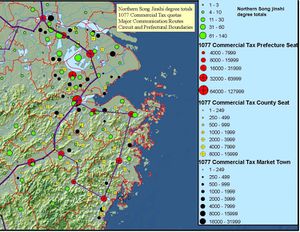Difference between revisions of "China Biographical Database"
(→History) |
(→History) |
||
| Line 3: | Line 3: | ||
==History== | ==History== | ||
| − | CBDB was originally started by the late Chinese historian Robert M. Hartwell (1932-1996).<ref>{{cite article|last1=Smith|first1=Paul J.|title="Obituary: Robert M. Hartwell (1932-1996)"|date=1997|publisher=Journal of Song Yuan Studies 27}}</ref> Hartwell first conceived of using a relational database to study the social and family networks of Song Dynasty officials. Aware of the lack of large dataset for research on the social history of middle period China, he took the first step to collect data himself and generate meaningful answers to historical changes through data analysis. Hartwell structured his data around | + | CBDB was originally started by the late Chinese historian Robert M. Hartwell (1932-1996).<ref>{{cite article|last1=Smith|first1=Paul J.|title="Obituary: Robert M. Hartwell (1932-1996)"|date=1997|publisher=Journal of Song Yuan Studies 27}}</ref> Hartwell first conceived of using a relational database to study the social and family networks of Song Dynasty officials. Aware of the lack of large dataset for research on the social history of middle period China, he took the first step to collect data himself and generate meaningful answers to historical changes through data analysis.<ref> Hartwell structured his data around |
#people, | #people, | ||
#places, | #places, | ||
Revision as of 19:41, 21 April 2018
The China Biographical Database (CBDB) is a relational database on Chinese historical figures from the 7th to 19th centuries. The database provides biographical information (name, date of birth and death, ancestral place, degrees and offices held, kinship and social associations, etc.) of approximately 417,000 individuals up till August 2017.[1]
History
CBDB was originally started by the late Chinese historian Robert M. Hartwell (1932-1996).[2] Hartwell first conceived of using a relational database to study the social and family networks of Song Dynasty officials. Aware of the lack of large dataset for research on the social history of middle period China, he took the first step to collect data himself and generate meaningful answers to historical changes through data analysis.Cite error: Closing </ref> missing for <ref> tag
CBDB is a long-term open-ended project. It has incorporated sources from biographical indexes 傳記資料索引 for Song 宋 (completed), Yuan 元 (completed), and Ming 明, birth-death dates for Qing 清 figures and listing of Song local officials. CBDB is also cooperating with other databases such as Ming Qing Women’s Writings (MQWW), Ming Qing Name Authority, and Pers-DB Knowledge Base of Tang Persons (Kyoto) to enrich its entries.[3]
Limitations
CBDB aims at extracting large amount of data from extant sources through data mining techniques. As a result, social and kinship associations, such as might be known from an individual’s literary collection, and funerary biographies are not exhaustive. Because of the nature of the sources, career data (e.g. ranks and positions a person held), will be biased toward higher offices. Since the database does not require in-depth research into each individuals, factual errors and contradictory information would also be included in the entries, as long as they are from the primary source.[4]
Geo-reference tools
One area in which CBDB could be used is prosopographical research.[5] By combining geographic information system (GIS) software with CBDB, patterns could be mapped out through queries generated from large datasets, for instance, who came from a certain place and what were the social and kinship connections among all those who entered government through the civil service examination from a certain place within a certain span of years, etc.[6] One useful geo-reference tool for the study of Chinese history is the China Historical GIS (CHGIS) project, which makes datasets of the administrative units between 221 BC and 1911 AD and major towns for the 1820–1911 period freely available. Other GIS software such as ArcGIS or MapInfo (or even GoogleEarth) are also compatible with CBDB output.

See also
References
- ↑ "China Biographical Database Project (CBDB)". Projects.iq.harvard.edu. 2016-11-07. Retrieved 2016-12-11.
- ↑ Smith, Paul J. (1997). ""Obituary: Robert M. Hartwell (1932-1996)"". Journal of Song Yuan Studies 27.
- ↑ Reviews of Internet resources for Asian Studies. "Resource: China Biographical Database Project (CBDB) [New Release]" (Jan 2011, Vol. 18, No. 1, 320). The Asian Studies WWW Monitor.
- ↑ "New Approaches in Chinese Digital Humanities - CBDB and Digging into Data Workshop". Peking University. Office of International Relations. 2016-01-11.
- ↑ Gerritsen, Anne (2008). "Prosopography and its Potential for Middle Period Research (Workshop on the Prosopography of Middle Period China: Using the China Biographical Database)". Journal of Song-Yuan Studies. 38: 161–201.
- ↑ "China Biographical Database | Qing Studies". Qing_studies.press.jhu.edu. Retrieved 2016-12-11.
Further reading
- Peter K. Bol, Chao-Lin Liu, and Hongsu Wang, Mining and Discovering Biographical Information in Difangzhi with a Language-Model-based Approach[1]
- Peter K. Bol, "The Late Robert M. Hartwell 'Chinese Historical Studies, Ltd.' Software Project," 1999[2]
- Anne Gerritsen, "Using the CBDB for the study of women and gender? Some of the pitfalls" December 2007[3]
- Fuller, Michael A. "The China Biographical Database User's Guide," February 28, 2015[4]
- "Online Guide to Querying and Reporting System," Academia Sinica[5]
- ↑ "Mining and Discovering Biographical Information in Difangzhi with a Language-Model-based Approach" (PDF). Arvix.org. Retrieved 2016-12-11.
- ↑ Peter Bol. "The Late Robert M. Hartwell "Chinese Historical Studies, Ltd." Software Project" (PDF). Pnclink.org. Retrieved 2016-12-11.
- ↑ Anne Gerritsen. "Using the CBDB for the study of women and gender? Some of the pitfalls" (PDF). Humanities.uci.edu. Retrieved 2016-12-11.
- ↑ Michael A. Fuller (February 28, 2015). "The China Biographical Database : User's Guide" (PDF). Projects.iq.harvard.edu. Retrieved 2016-12-11.
- ↑ "CBDB Querying and Reporting System - Online Help". Db1.ihp.sinica.edu.tw. Retrieved 2016-12-11.